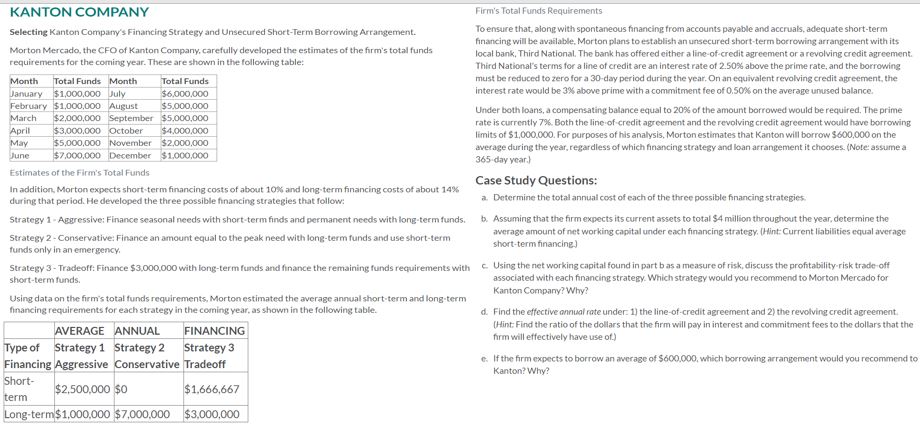Answered step by step
Verified Expert Solution
Question
1 Approved Answer
I don't understand this. Please thoroughly explain. I ' m trying to complete with paper and pencil. Please fully explain how I show calculate not
I don't understand this. Please thoroughly explain. Im trying to complete with paper and pencil. Please fully explain how I show calculate not understanding how.
KANTON COMPANY
Selecting Kanton Compary's Financing Strategy and Unsecured ShortTerm Borrowing Arrangement.
Morton Mercado, the CFO of Kanton Company, carefully developed the estimates of the firm's total funds
requirements for the coming year. These are shown in the following table:
Estimates of the Firm's Total Funds
In addition, Morton expects shortterm financing costs of about and longterm financing costs of about
during that period. He developed the three possible financing strategies that follow:
Strategy Aggressive: Finance seasonal needs with shortterm finds and permanent needs with longterm funds.
Strategy Conservative: Finance an amount equal to the peak need with longterm funds and use shortterm
funds only in an emergency.
Strategy Tradeoff: Finance $ with longterm funds and finance the remaining funds requirements with
shortterm funds.
Using data on the firm's total funds requirements, Morton estimated the average annual shortterm and longterm
financing requirements for each strategy in the coming year, as shown in the following table.
Firm's Total Funds Requirements
To ensure that, along with spontaneous financing from accounts payable and accruals, adequate shortterm
financing will be available. Morton plans to establish an unsecured shortterm bocrowing arrangement with its
local bank, Third National. The bank has offered either a lineofcredit agr eement or a revolving credit agreement.
Third National's terms for a line of credit are an interest rate of above the prime rate, and the borrowing
must be reduced to zero for a day period during the year. On an equivalent revolving credit agreement, the
interest rate would be above prime with a commitment fee of on the average unused balance.
Under both loans, a compensating balance equal to of the amount borrowed would be required. The prime
rate is currently Both the lineofcredit agreement and the revolving credit agreement would have borrowing
limits of $ For purposes of his analysis, Mortonestimates that Kanton will borrow $ on the
average during the year, regardless of which financing strategy and loan arrangement it chooses. Note assume a
day year.
Case Study Questions:
a Determine the total annual cost of each of the three possible financing strategies
b Assuming that the firm expects its current assets to total $ million throughout the year, determine the
awerage amount of net working capital under each financing strategy. Hlint: Current liabilities equal average
shortterm financing.
c Using the net working capital found in part as a measure of risk, discuss the profitabilityrisk tradeoff
associated with each financing strategy. Which strategy would you recommend to Morton Mercado for
Kanton Company? Why?
d Find the effective onnual rate under: the lineofcredit agreement and the revolving credit agreement.
Hint: Find the ratio of the dollars that the firm will pay in interest and commitment fees to the dollars that the
firm will effectively have use of
e If the firm expects to borrow an average of $ which borrowing arrangement would you recommend to
Kanton? Why?

Step by Step Solution
There are 3 Steps involved in it
Step: 1

Get Instant Access to Expert-Tailored Solutions
See step-by-step solutions with expert insights and AI powered tools for academic success
Step: 2

Step: 3

Ace Your Homework with AI
Get the answers you need in no time with our AI-driven, step-by-step assistance
Get Started


